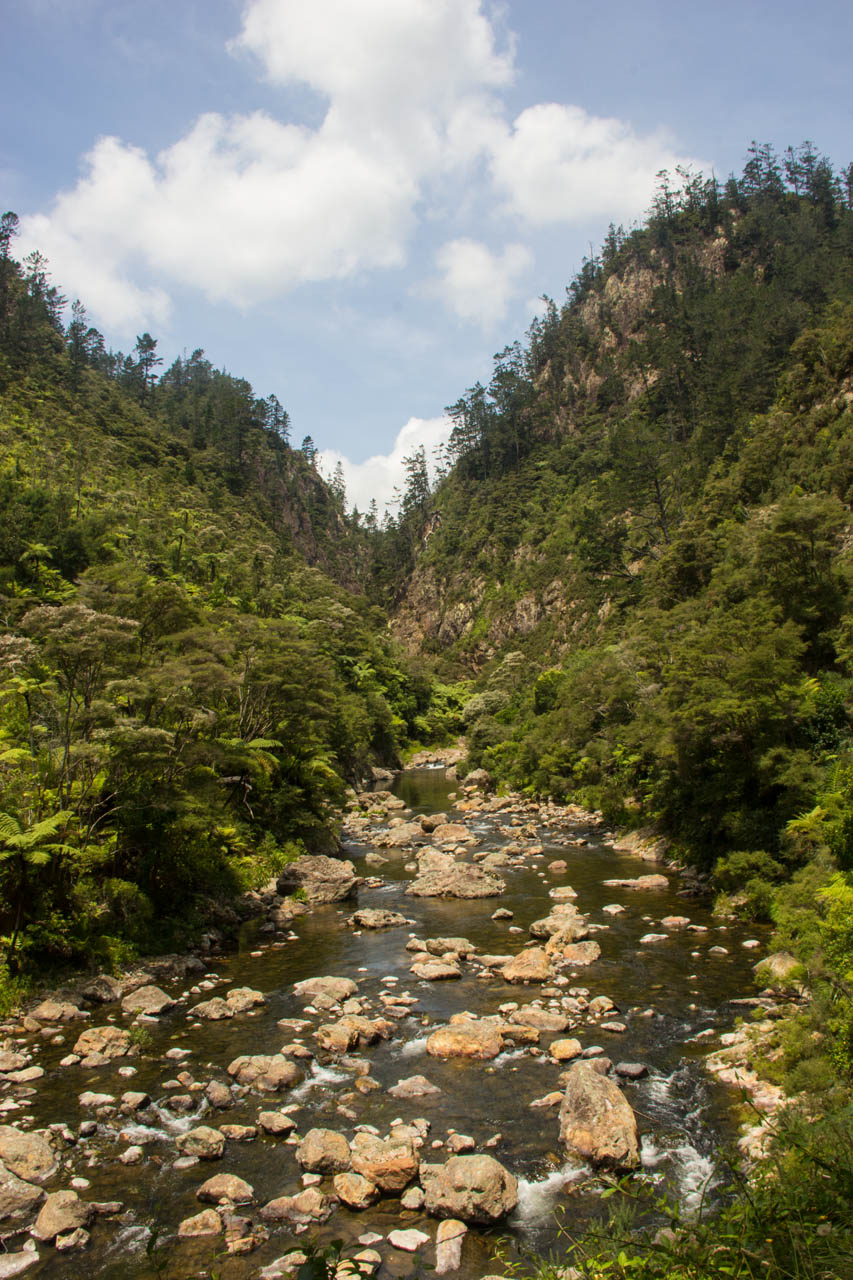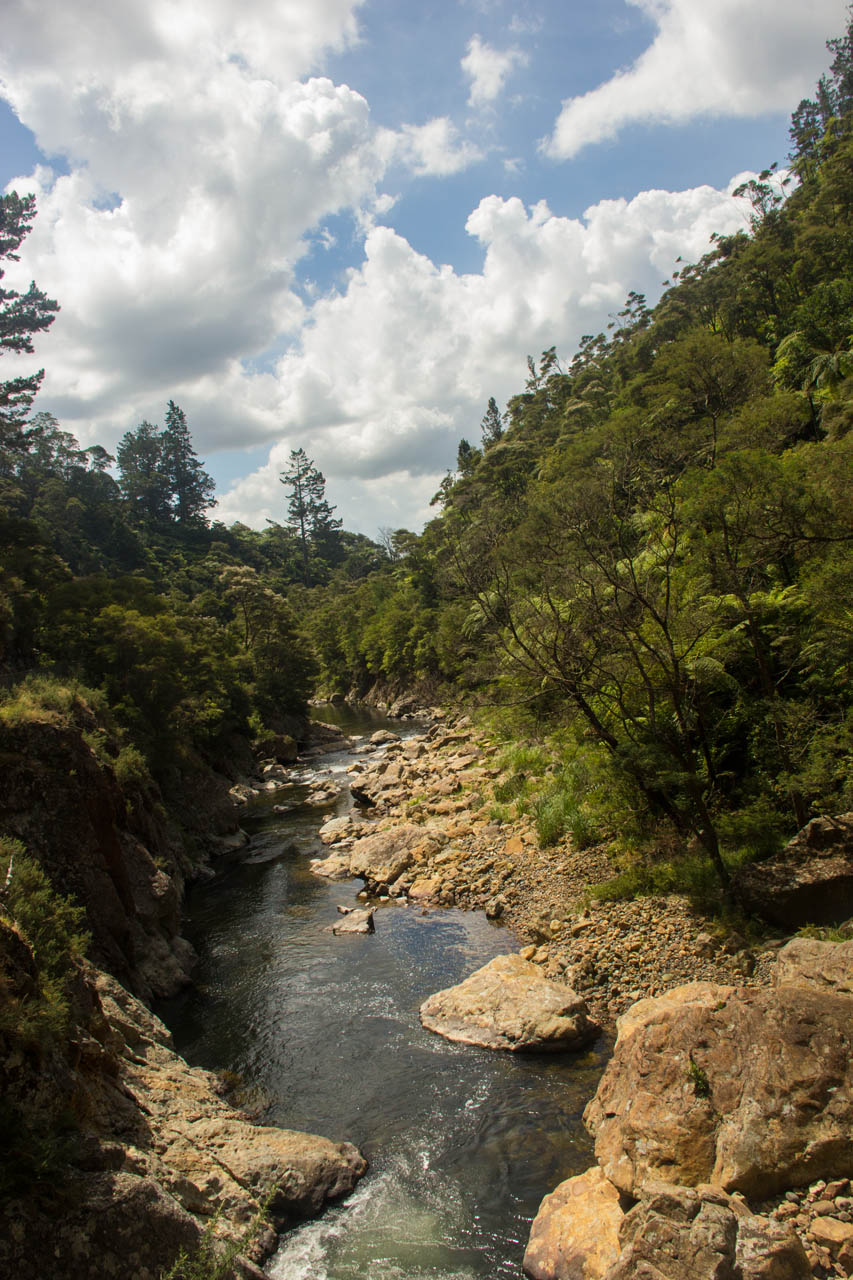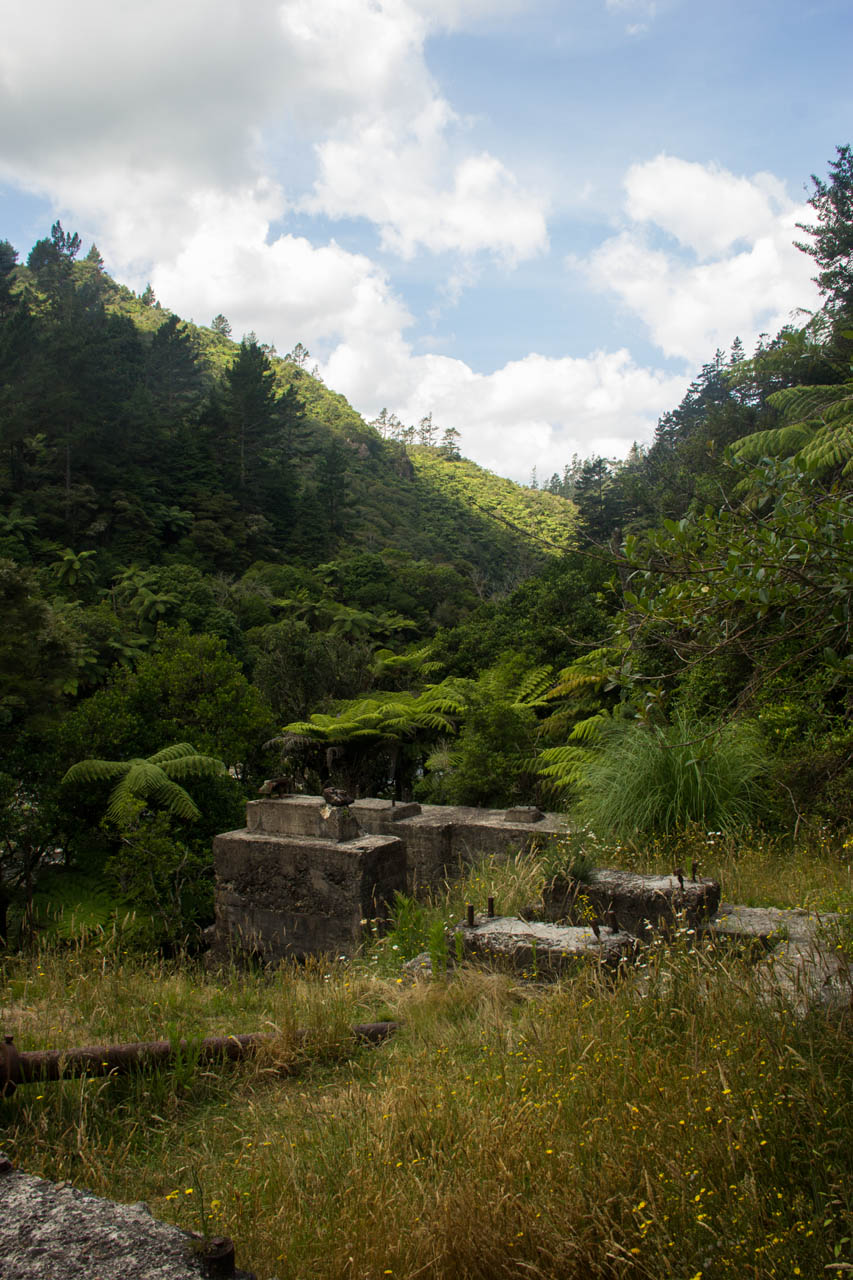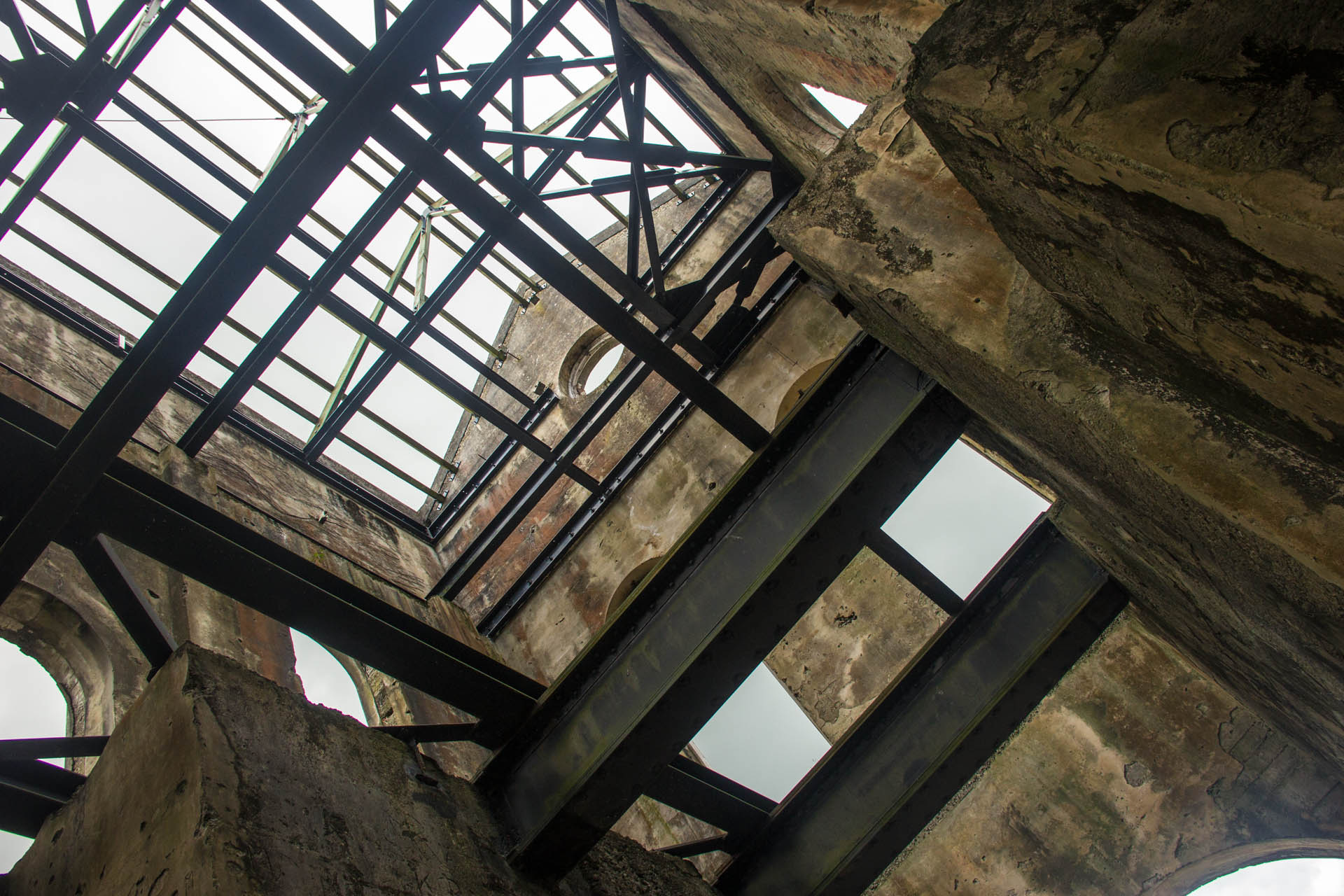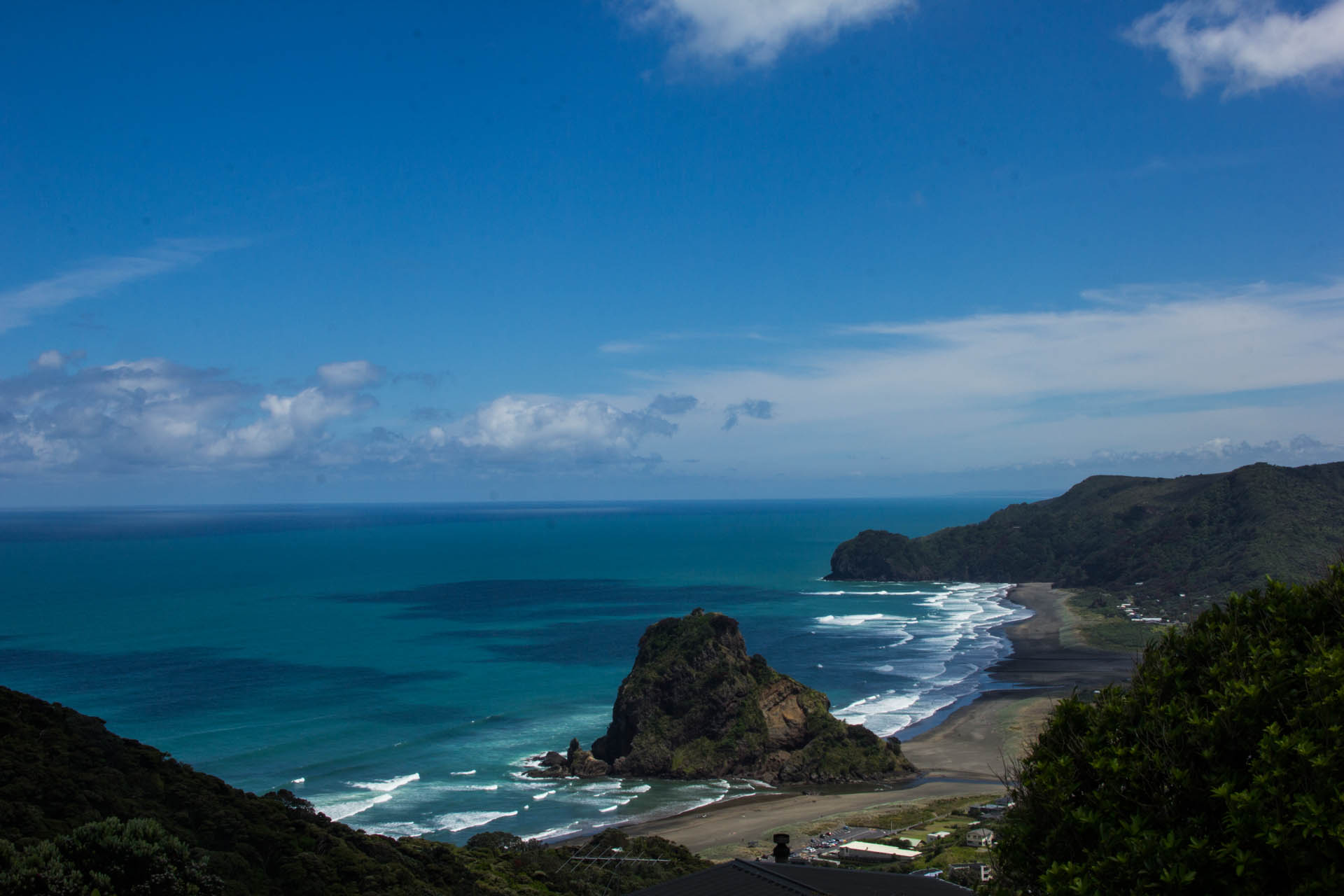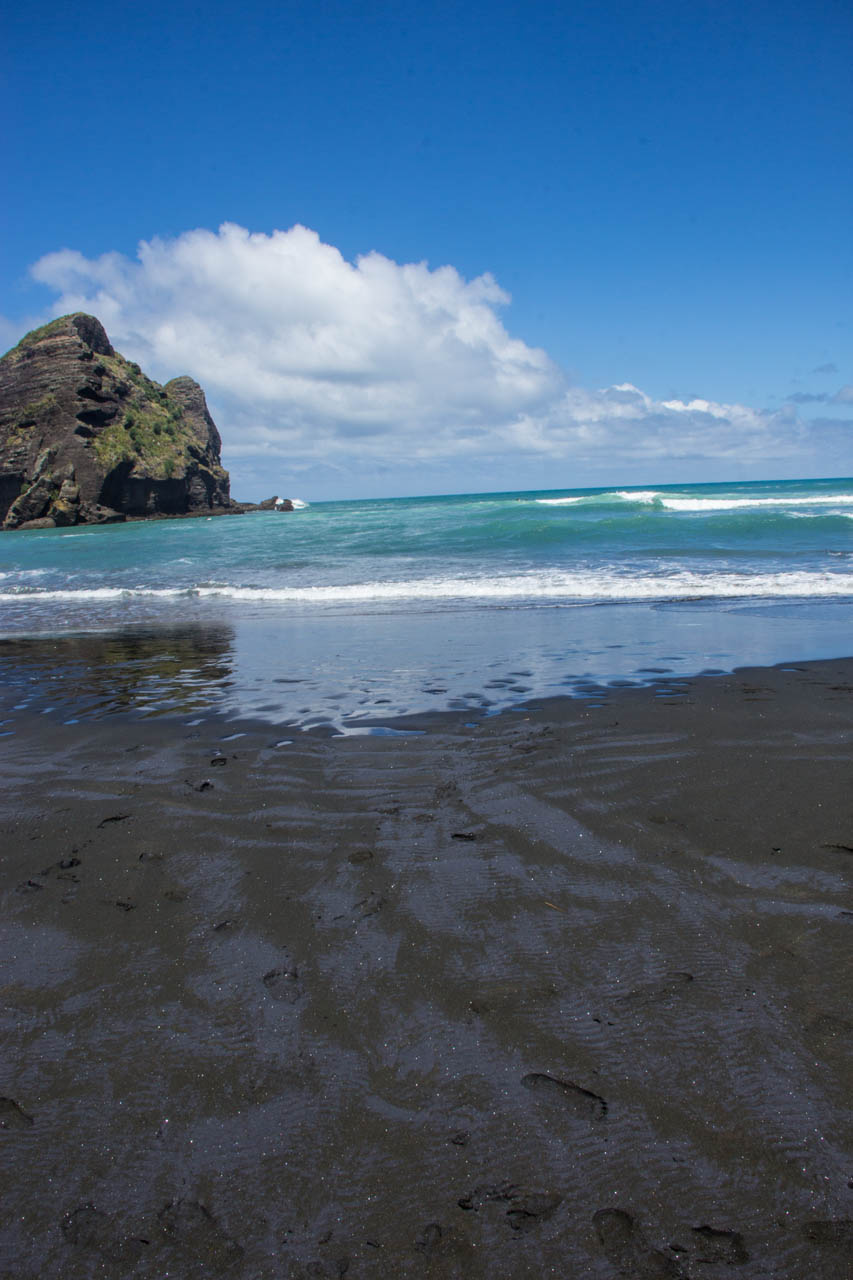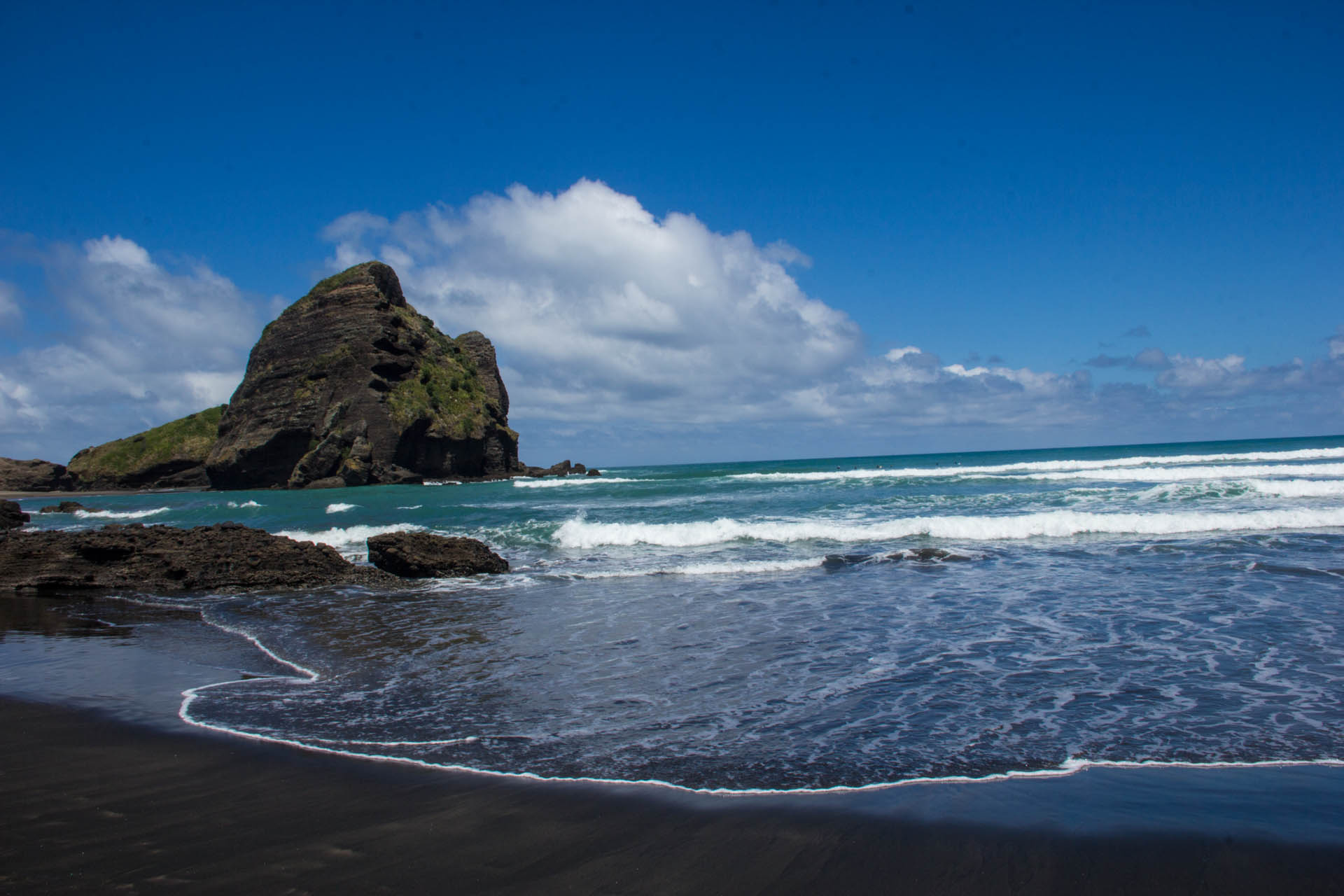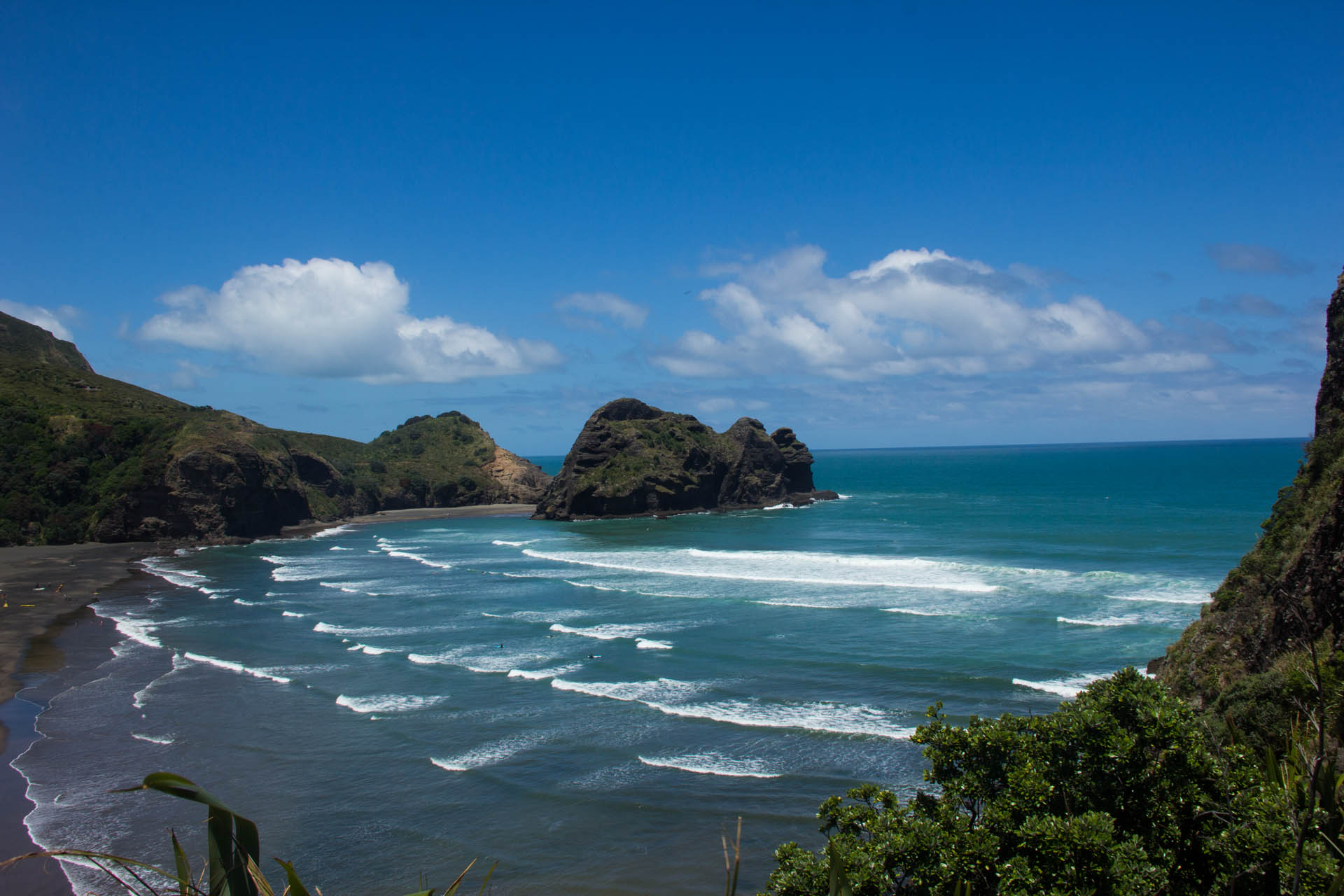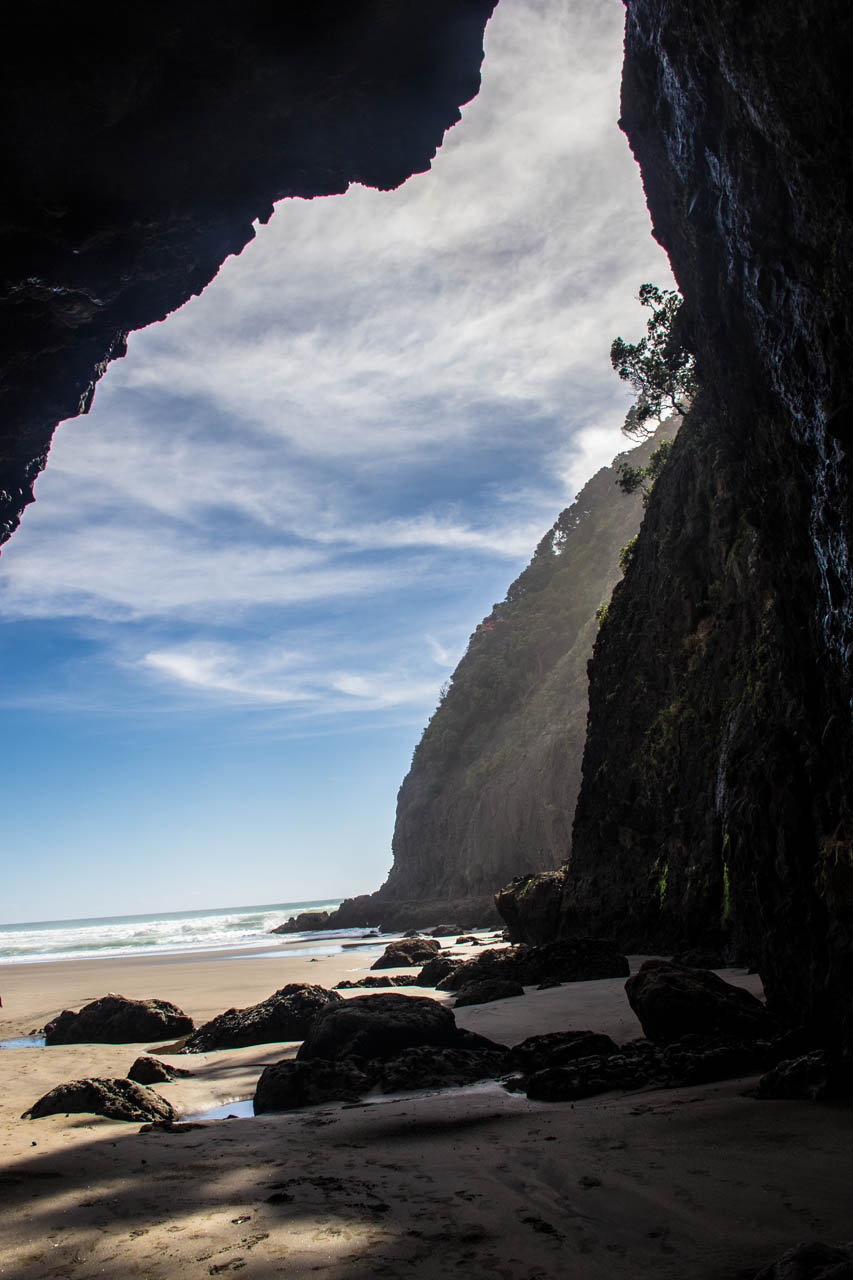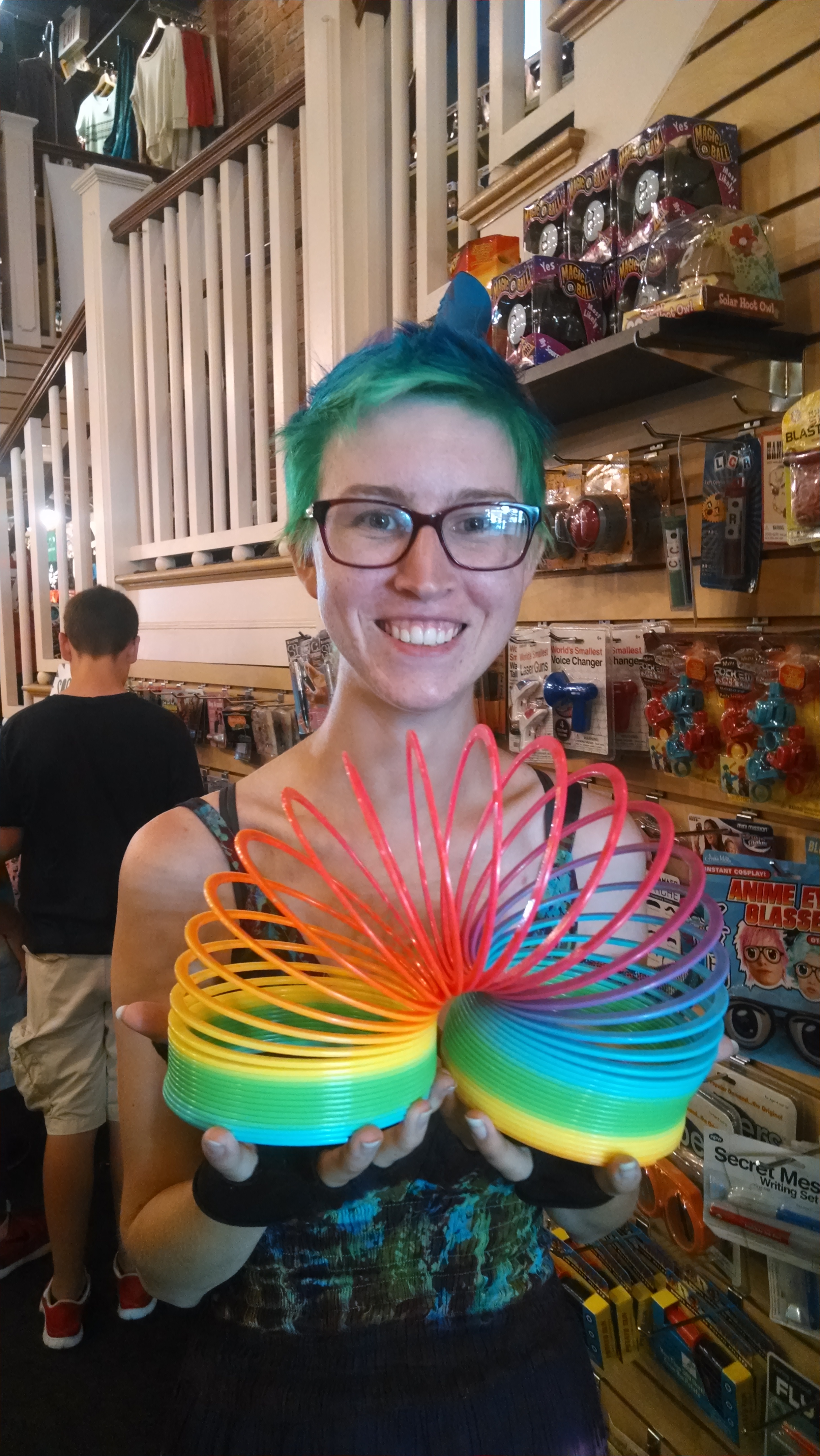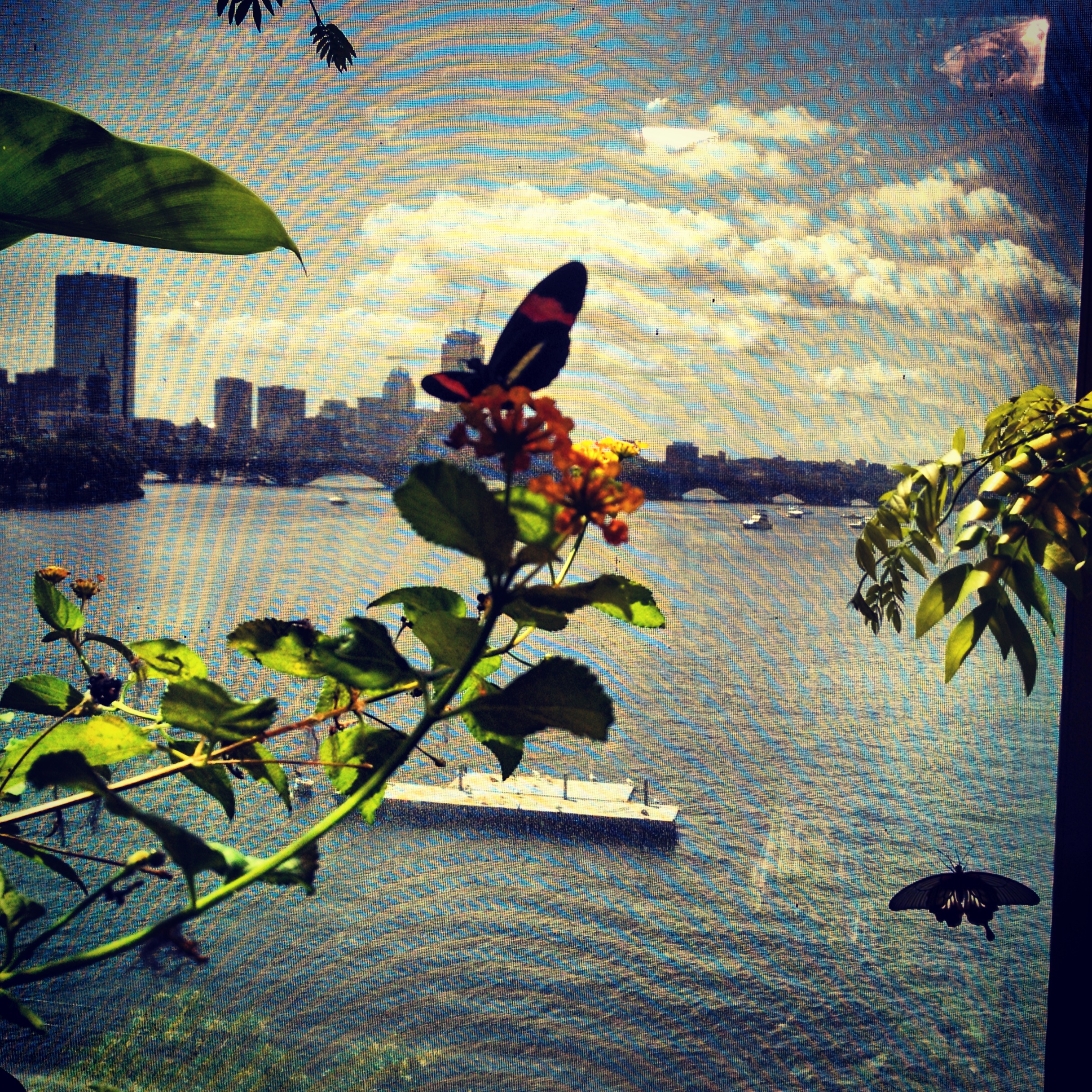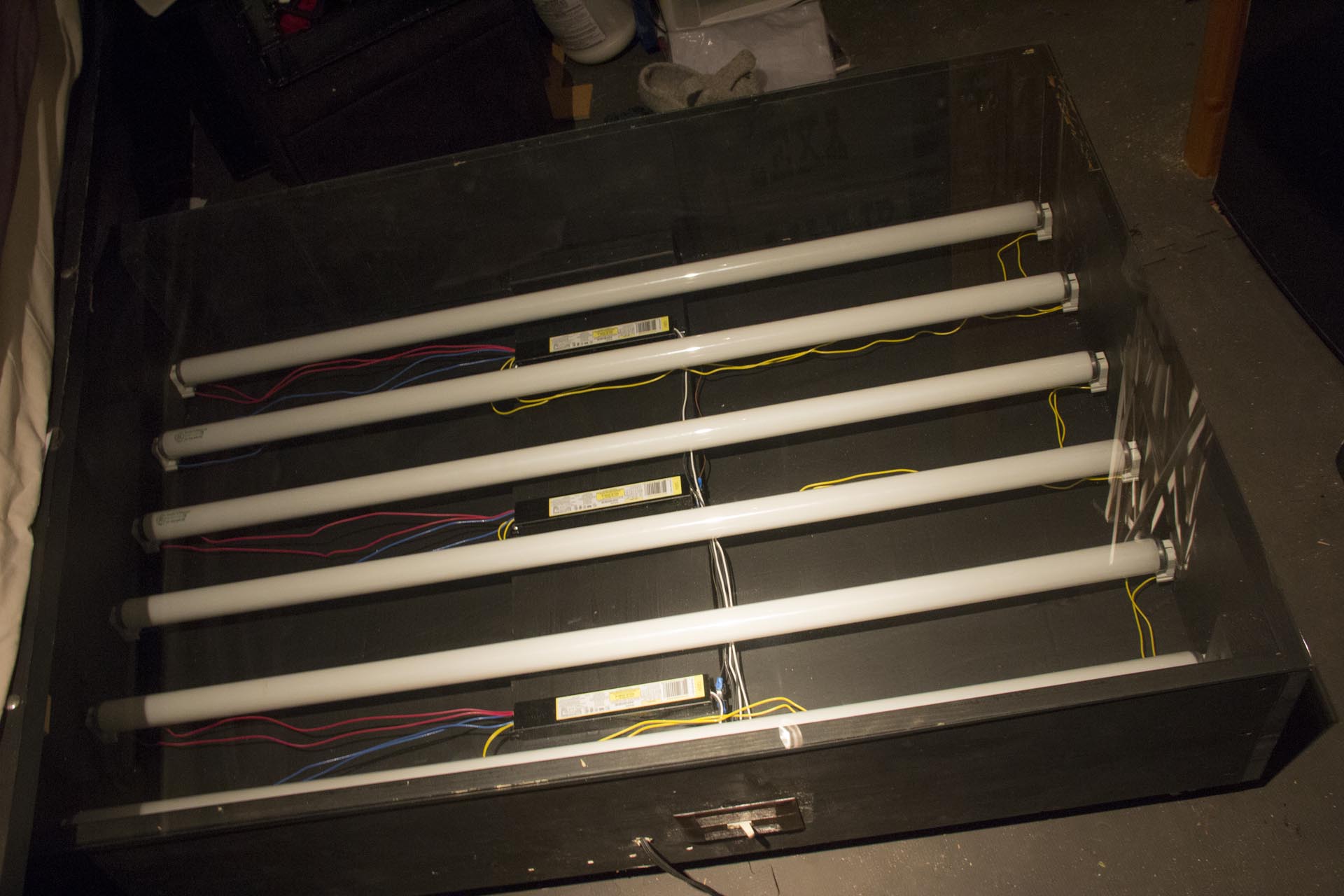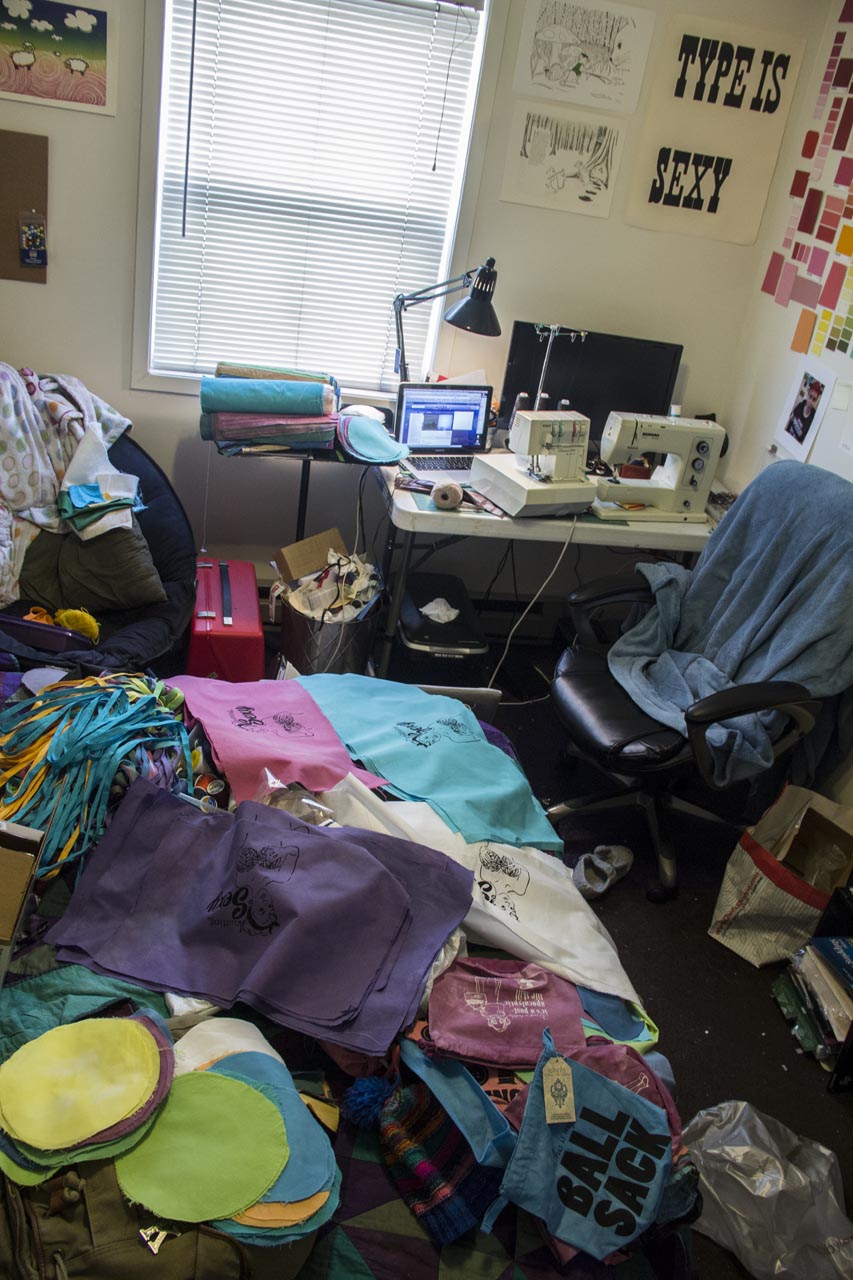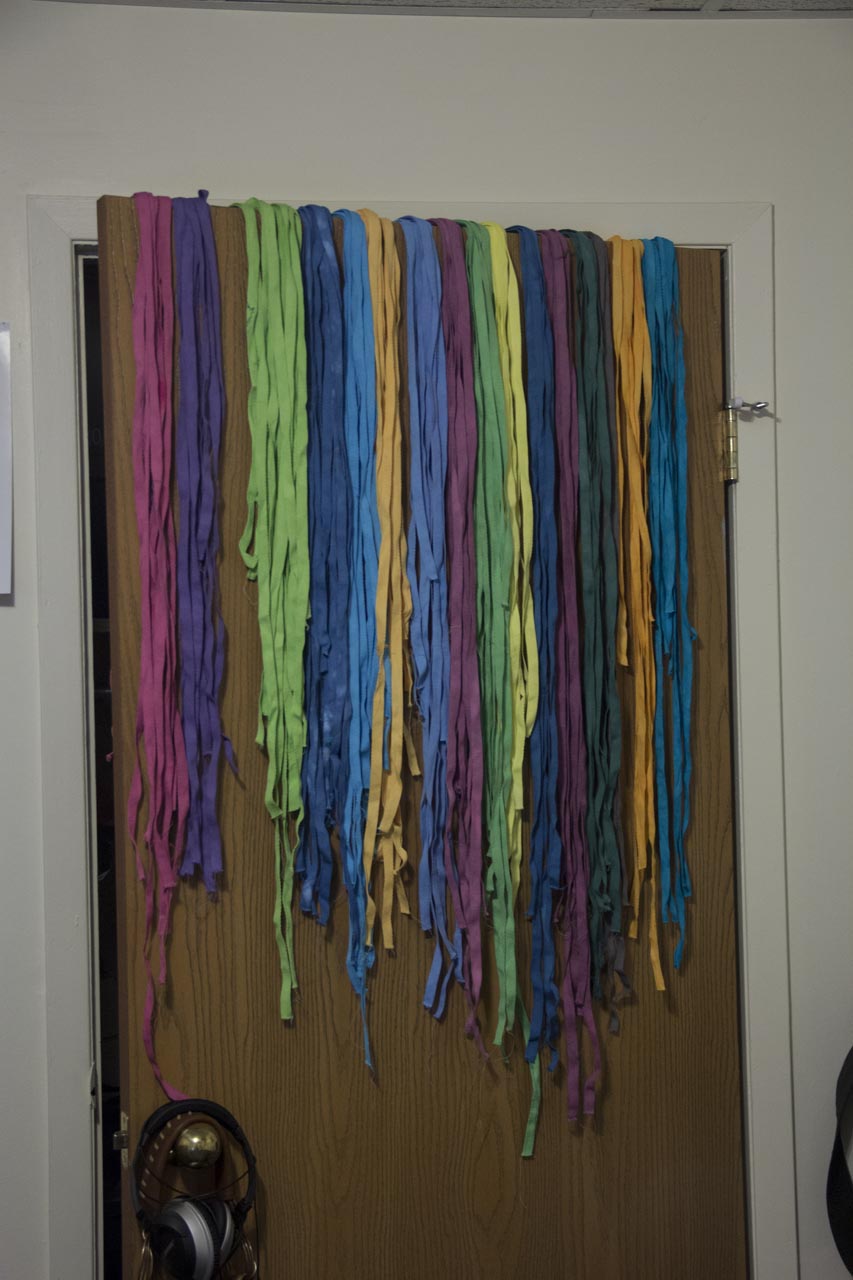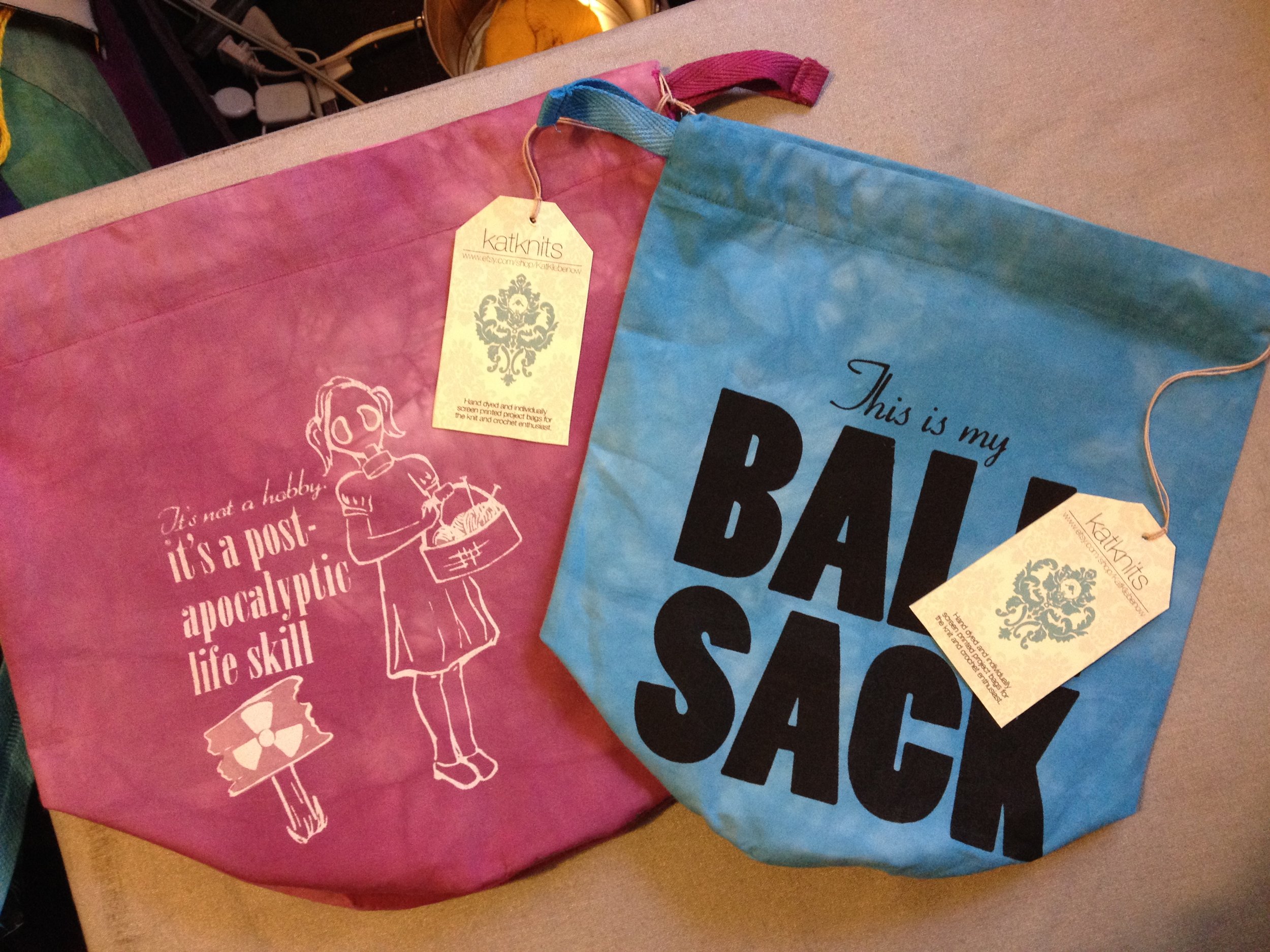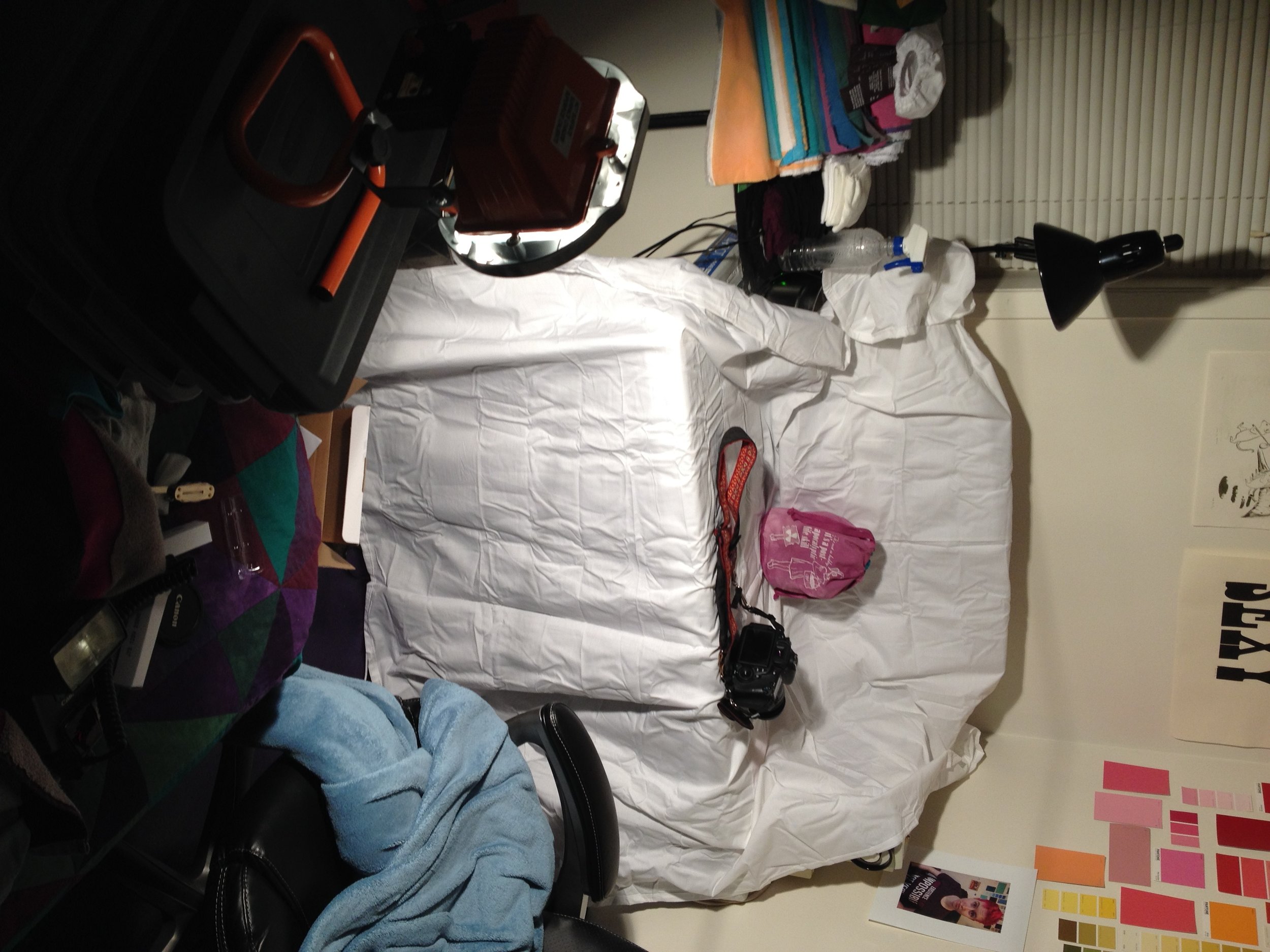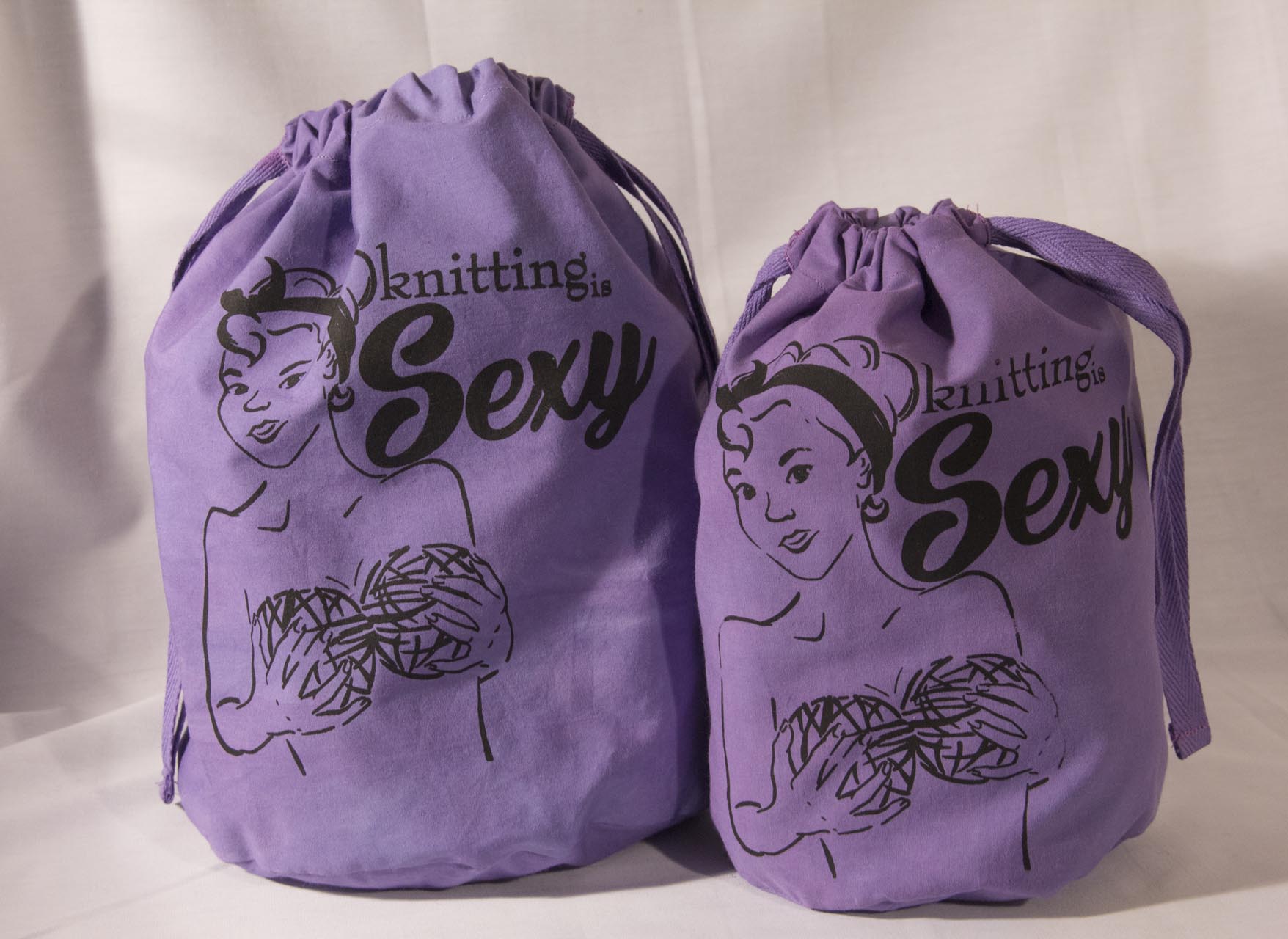In which the perfect hiking shirt is made, and an adventure is had.
Read MoreThe Floral Satin Bustier
Basically, I've conquered the world in the form of a floral satin bustier, and I'm thrilled to bits.
Read MoreThe Traveller Dress
In which I take advantage of Kiwi resources (and sheep), make a dress, and go on an adventure.
Read MoreWith Pockets to Hold All My Secrets
Drafting and sewing a jumpsuit that hugs like a cloud, and with pockets to, well, you know.
Read MoreIn Which the History of Gold is Deceptively Rusty (but still pretty awesome)
The next New Zealand weekend adventure found us driving down winding mountain roads on a day that seemed unbearably hot in the sun, yet just the right side of chilly in the shade. It seemed the former wasn't much of an issue, because the place we were going had plenty of trees- not to mention some other pretty wonderful things:
Welcome to Karangahake Gorge! Aside from its position as a truly spectacular piece of nature, this area is filled with the rich and ongoing history of its own: Gold. I'm used to elementary school stories of men heading west to California to pan for gold in the rivers, but this venture was a little bit more subterranean. You're looking at a turn of the century gold mine, and although mining here was suspended decades ago, there is still as they say, gold in them there hills.
Karangahake Gorge is now a reserve space with some truly fabulous walking trails that I will get to in a minute, but also some pretty great informational signage about it's history. I may or may not be a huge nerd about informational signage- it's just nice to see a thing, and then learn about the significance of that thing, is all. Example: this is the view looking over the main battery. Excavated dirt (with the gold ore mixed in) was brought to this building using water from the river, where it was pulverized ("battery" like "battering ram" not the kind you stick in flashlights. This was before widespread electricity was a thing) -so the gold could be extracted. At one time, this area was responsible for more than 60% of the gold production in New Zealand.
There are a few trail options around Karangahake Gorge, but I was informed that the underground pump house and windows walk were going to be our best options. The walking path here follows what was previously train tracks: used to carry gold ore out of the mountains. It's carved into solid rock at the edge of the gorge with a very solid railing to protect curious types from the 50- to 75- foot drop into shallow, rocky water below. In some areas, the tracks have themselves experienced that fall. The twisted, mangled remains of steel and the occasional rail road tie or pipe have settled in the water below, and a new trail has been carved deeper into the gorge next to the washed out area.
Although it's a reserve, and meant for exploration- some areas of the mine are still dangerous and closed off to the public.
Gotta keep those hobbits from sneaking through the mine shafts, you know. Pesky Bagginses and their shortcuts and invisible gold rings. I wonder if there's invisible gold in these mountains!?
But what's this ahead? Could it be? My first ever real live swing bridge?!
We paused for a photo-op, of course, because- let me 'splain you a thing'-when you've spent the majority of your life (and all of your independent adventuring life) smack in the middle of the Midwestern United States- there are no swing bridges. This is because in the Midwestern United States there are no hills to connect with bridges. Everything is flat. Flat and ocean-less and full of farms with corn and cows. Swing bridges and oceans were two things I wasn't really sure I needed until I had experienced them, and let me tell you, swing bridges are pretty awesome.
Say Cheese!
The swing bridge took us up a path to a sign that said the underground pump house walk was currently closed- disappointing, because that just sounds pretty awesome. We hypothesized that there were structural issues and hoped they were temporary. Karangahake Gorge is a day-trip's drive from Auckland, and I intend to go back to see if it's open. We did, however, get to experience the famous 'Windows Walk'.
After a great many stairs (so many stairs...) we follow a dark tunnel cut into the side of the mountain. From the main tunnel, several auxiliary tunnels are carved both right- further into the mountain, and left- out to the steep cliff and overlooking the river. These left tunnels end in 'windows' which we use for light as we wander through, and which the miners used to deposit whatever they dug out of the mountain into waiting train cars below. From one of the windows, we looked down and saw the swing bridge we crossed to get to this point:
About halfway up the left side of this photo is a little dark spot- that's the entrance to the Windows Walk- at the top of the stairs. Unfortunately, this area was also plagued with some structural issues. Only half of the walk was open, after which a barricade forced us to turn around and head back. Usually, the carved tunnel goes all the way back to the beginning and deposits you in the parking lot where you started, but hey- another reason to go back, right? We took a little detour to follow that train track from before in a new direction- here you can see the old path falling away and the new path next to it.
Some of you may recall that I did a semester-long black and white film photography study on the process by which nature constantly attempts (and succeeds) to break down and take back the byproducts of human intervention. This place was ripe with exactly that- old, rusty bits of machinery abandoned by anxious entrepreneurs on to the Next Big Idea, the worn train tracks and water pipes still in place amongst new growth of trees and shrubberies. As soon as we humans turn our back on something, nature begins the slow reclamation process.
There are some opportunities to climb around on the old machinery- or if you're a huge nerd like me, to take pictures of it. It seems in every capacity like the miners rushed out as quickly as they rushed in- leaving the slowly rusting detritus of their trade wherever it happened to land.
I wonder if the miners appreciated the views they had in these mountains while they were prospecting. Probably not, deep in the belly of the mountains, but maybe when they came up for air. This place is nestled amidst mountains and is a beautiful thing all it's own. Maybe it was less so when the miners were uprooting it for minerals but nature has had the better part of a century to take it back now, and she's done an admirable job softening its hard edges.
After that healthy dose of green, and the positivity that is nature reclaiming land after the mines were abandoned- we drove a little further to an actual, real-live present day mining town with an active pit mine.
Things happen a bit differently these days, with open pit mines instead of tunnels and shafts. There is a building down there, a house-sized office of some sort- and heavy machinery for the digging of the gold, but everything is miniscule in comparison to the size of this hole in the ground. There were guards patrolling the top of the mine (five, by my count)- probably to keep hooligans and activists from causing problems. I wonder if they get that a lot. The Kaimai ranges (Where the Karangahake Gorge Mine was located) are still filled with gold, but the protected land status means it can't be mined. Currently. This area wasn't so lucky, but given enough time after it's abandoned in search of more lucrative ventures- I have confidence that nature will take back this pit and make it once again beautiful. With our back to the pit mine buzzing with activity, we were met with a very interesting site: at the end of a pair of tracks was a suspiciously old looking building with a suspiciously new looking foundation.
The Cornish Pump House was a relic of bygone days when water was used to power the mines. It fell out of use when it was replaced with electricity, but was preserved because of its historic significance. The informational signage here was a little sparse, but between that and the internet we figured out the basic story: In 2006, surveyors realized that the ground the old pump house stood on was unstable because of the mining operations right next door, and a very large effort was made to relocate it. The tracks are teflon-coated concrete pads which the pump house was slid along on for 300 meters to its new resting place as you see it today. Visitors can wander around inside and see how the operation worked (and which spots are now the best places for bird's nests as they flit about above...) and if you're a huge nerd like me, take pictures of the architecture.
It's sort of nice to see the old parts standing watch over the new things, as if to say that everything will settle back into its rightful place eventually. I love adventures like this- and it's not often you get to see the progression of history right up through present day- even if the present day part isn't exactly all warm and fuzzy. Who knows what these places will look like in a century- they've certainly changed a lot in the previous century. It might just be that I have a soft spot for historic places, and you know how exciting the Piha adventure was- how am I supposed to pick a favorite, though? Was Piha better than Karangahake Gorge? I'm refusing to answer that question. On principal.
(Retroactive) Containment Issues
Preface: I may have kinda sorta stopped blogging because I was too busy having crazy wild fun in New Zealand... I'm back in St. Louis now- so prepare yourselves for some hardcore retroactive adventure blogging! Here's the thing. I went on this adventure- and the whole thing lasted, in its entirety, for approximately 8 hours. As far as adventures go, that's just a blink of a moment in time...especially since two of the hours in question were spent driving to and from the destination. Especially since this whole 3 month New Zealand trip is an adventure. Especially since all life is an adventure.
But get this. I'm going to have to split that 8 hours up into three blog posts, because otherwise the level of grand miraculousness that occurred on this adventure will not adequately be described and that, my friends, would be a travesty.
You see, before The Void took me to New Zealand, the number of times I had personally interacted with oceans could be counted on three fingers. After just a few weeks, I'd encountered my fair share of beaches and oceans, and up until this day I felt like I had a pretty good handle on the whole situation.
But then this happened:
New Zealand separates the Pacific ocean (east) from the Tasman sea (west)- and further along west is Australia. It's not one of those "I can see Russia from my house" type scenarios though- it's a bit further away than that. Piha was my first experience with the Tasman sea, all the other beaches I'd been to so far were on the Pacific side.
Sheep insisted his picture be taken before we moved on:
As a side note, shortly after this trip Sheep created his very own Tumblr and he's pretty popular. Like, way more popular than me...
I took 491 photos of this adventure (part of the reason it's getting split up into three posts)- and you'll see why. How can you not when everything's just so pretty?
One of the first things I noticed when we got out of the car was the sand- It's called a black sand beach, but really it's a combination of normal colored sand and iron from volcanic rocks, which darkens and gives everything beautiful, shimmery effect. The beach literally sparkles, and it's fabulous.
The iron deposits are washed up by the waves, and sit on top of the sand. Next time, I'm bringing a magnet and science is going to go down.
The second thing you should probably know about Piha is that it's one of the most dangerous beaches in New Zealand. It's one of few surf beaches I've been to, and the currents here are so dangerous that it has it's own TV show: "Piha Rescue". - However, the waves are pretty excellent.
The trip was mostly exploratory, though. I still can't surf (patience, grasshopper. Next time), and the water's a bit chilly anyways- but it's gorgeous even if you choose to stick to dry ground. There are three sections of the beach, and it's safe to say that the most interesting bits are only accessible at low tide. By a very lucky coincidence, our visit was well-timed.
Not only did we get there just as the tide was going out, it went out much further than usual while we were there. According to Google and my middle school science teacher, this is called a "Spring Tide" and occurs during new and full moons. The more you know.
As we were looking around (read: as I was taking pictures of the ground...) Jon told me about a second beach that is only accessible at low tide (it's a fairly common dilemma with the beaches here), and although the tide was going out, it wasn't low enough yet. While we waited for the water level to go down, we wandered over towards another interesting landmark.
Lion Rock! it looks more or less like a lion depending on where you stand, but the general idea is there. When the Māori lived here, they used Lion Rock as a lookout and defensive position, and were quite successful at defending their land from invaders for a very long time.
It's a short, steep climb up to the lookout, and definitely worth it for the views. If you look closely, you can even see a few tiny surfers amongst the waves! Straight ahead you can see the extension of beach that I talked about earlier- we'll get to that in a minute.
There's a little grassy patch on top of the lion's head for your sunbathing pleasure, and it also happens to afford a pretty fantastic view of the beach and village below. From the top, I learned a thing or two about what, exactly, makes Piha so dangerous. There's just the boisterously breaking waves crashing up onto the beach if you look to the south, but looking over the north beach is a different story entirely. There, amongst the breakers, you can see the twisting patterns the rip tides create in the surf, and the places where the pull is so strong that it drags sand up from the ocean floor. This definitely isn't a swimming beach- and when people don't heed that warning, it makes for some very dramatic television.
For a bit of a reference, here's a view of the climb back down Lion Rock. It's a steep and well worn path, but not an issue even if you're not very sure-footed. One thing I discovered pretty quickly is that aside from my low level of general physical fitness, I specifically have a pretty awful sense of balance. Even though I felt like I was going to fall for most of the walk, I still managed to do it without so much as a skinned knee.
After climbing down from Lion Rock and a quick snack break, the tide was low enough for some secret-beach explorations. We climbed over the barnacle-encrusted rocks and stopped to investigate many a tide pool ecosystem, and I took some pictures to document my efforts at keeping my bright pink dye job from fading in the sunlight. New Zealand's UV rays are, after all, 40% more intense than the ones in the US.
After a bit of climbing, and some hilarious moments concerning my inability to balance myself upright with anything less than three points of contact -(I see you there. You think I'm kidding. I'm not.)- this is what we saw:
This whole 'Grand Adventure in Three Parts' occurred on a Monday, which is not-generally speaking- a very popular day for beachgoers, so the whole place was virtually empty. Even fewer people ventured around to this little corner, so my job as ~Official Photographic Evidence Gatherer~ was pretty easy. You'd have to actively try to take boring, ugly pictures of this place.
If you walk all the way down so far that you run out of sand, this is what you see. The beach gives way to nothingness, separated from the ocean only by a rocky outcropping against which the waves crash violently (in sets of seven, I learned). Behind this is an area where, I was informed, seals and penguins might bring their young to keep them safe while fishing. Alas, it was neither seal nor penguin season, so we didn't spot any mammals this trip (other sea life on the other hand... well, stay tuned for part 2!)
Three pictures ago, you may have noticed a rock to the right of the beach. Here's another view:
This little channel goes, obviously, all the way through the rock. Apparently people (more adventurous than myself) even swim through it! Nature is the coolest thing ever.
We decided to spend the hottest part of the day in the shade by taking a short hike up into the hills to see a waterfall; but that's part three of this little adventure. After that, and lunch under a flowering Pohutukawa tree, we tried our luck at the north end of the beach.
This end had a whole bunch of truly fabulous tide pools and sea life that we are not talking about until next week because there is too much and it is overwhelming and even as it is I may still explode...
There was also this very cool cave.
Below, we can see a very nice specimen of mermaid hair, which as we all learned in school, grows on the rocks until it is long enough that it can be harvested and worn by the mermaids.
The mermaids, because of this, have bright green hair which blends nicely with the green-blue of their oceanic habitats as well as the various jewel tones of their tails. Of course, some of the more rebellious mermaids have been known to dye their hair 'weird' colors like blonde and brunette, and some of them don't even tell their parents they're doing it first. Some people will attempt to convince you that this is not mermaid hair at all and is instead seaweed, but those people are wrong.
As the sun went down and the tide started to roll back in, (neither the first, nor the last time we almost got caught by the tide on this trip) we headed back to the car, I took pictures of the colors changing as the daylight faded, and we evaluated the condition of our sunburns and tan lines.
Did you make it? Are you with me here at the end of this post? Did you scroll through the pictures thinking to yourself: "My, they just keep going- when will it end?" - well here it is. I've made it through one third of this single-day adventure. Probably less than a third, if you consider the number of photos I have for next week's post. This is what happens when you release someone with a formal education in photography on a beach for (basically) the first time in her life and tell her to go crazy. I can, having already returned from this trip to New Zealand ('tis only the first of many!), look back on this adventure in comparison to everything else that happened and say with pretty secure certainty that it was still one of the best parts of the trip. There are so many things you don't think about when you don't experience them firsthand. Sure, you learn in elementary school that the ocean's tide goes in and out- that there are seven quintillion, five hundred quadrillion grains of sand in the world, that crashing waves carve patterns in rocks, and that a variety of sea life living in these nifty little things called 'tide pools'- but until you see it? I don't think you fully understand it until you're standing in the middle of it, and it's jumping up to nibble at your unsuspecting toes.
A Rainbow in Maine (with a little help from my friends)
It's incredible to me- and I don't think you can understand it unless you've experienced it- how quickly the people you meet in the places you end up go from strangers to best friends. I met so many people at camp, and I won't forget a single one of them. They're all such wonderful people, and sure, some of them got on my nerves sometimes (six cups of my coffee at once, Wojciech. We have to ration the caffeine!) and some of them I didn't get to know as well as I would have liked (Brodsky- even though I'm still not sure if you're a bigger feminist than me, you're still pretty awesome.) The only thing I can think that might be responsible for all the bonds we've formed is the environment that camp has created for us. Whatever it is, these people are my people now- and I love them all.
One very special and particularly important person is the reason I not only retained my sanity, but also ended up with rainbow hair for half of the summer! Ashley, it seems that this is the only photo I have of us together- which is tragic- but at least that night was loads of fun! I'll have to come to New Jersey and then we can take a million selfies and I'll do a blog post all about our adventures.
We both stayed up way past bedtime and painted a Manic Panic rainbow into my hair:
After sending her an early-morning completed-hair selfie so that we could make sure that she was the first to see it (that's only fair)- I paraded this new look around for the rest of camp!
As a side note to all you boys and girls out there who are afraid to dye your hair interesting colors because you're afraid you'll reduce your job prospects- that is silly. If I can do this, so can you. Rainbow hair, much like Camp, is all about expressing yourself in ways the rest of the world may not necessarily agree with, and it's a good way to test out things before you take them out into the real world. I, for the record, also got hired and currently have a full time job in the field I went to college for and was hired for said job with this very head of rainbow hair.
Take that, society.

My freshly rainbowed hair coincided (totally on purpose) with my last two days off, which were spent wandering the busy streets of Boston and having Huge Nerd Moments about history (and teaching a certain person from New Zealand that The Boston Tea Party was not a literal tea party)...
Boston is a really excellent city for history-viewing, because it's all in a very small, walkable area and they even have these clever lines in the sidewalk (the freedom trail) to let you know if you're close to something, and what it is. Paul Revere, incidentally, is buried in the same cemetery as Mother Goose, so we got to see that too. After time spent in some really interesting and cool graveyards, we headed to a shopping area to people watch (and, okay, maybe shop a little tiny bit...)
I found this giant rainbow slinky in Newbury Comics, and obviously a girl with rainbow hair who finds her first giant rainbow slinky has to document the experience...
Day two centered around a field trip to the Science Center- which is located next to a loch, and whose main set of windows overlooks a pretty spectacular skyline. There's also a butterfly house on the roof (also overlooking said skyline)- which makes it practically the coolest thing I can currently think of.
They say if a butterfly lands on you it's good luck- but what if it doesn't stay there long enough for you to take a photo? One of this little guy's friends sat on my wrist for a couple of seconds until he was distracted by a colorful flower.
These butterflies (much like the sheep in Bath or the ones in the pasture next to Stonehenge) don't know how jealous I am that their views are better than mine.
On our way to a fantastic little Irish Pub for dinner, we passed the site of the Boston Massacre, and Sheep insisted that we stop for selfies. Sheep insists that this is the epitome of American tourism and is not an opportunity to be missed.
City Hall, where that particular historical event occurred, obviously still exists in Boston. The incredible thing about it, though, is that nothing else that originally surrounded it is still intact. Instead, it's been blocked in by tall skyscrapers and taller skyscrapers. That little building has a completely different view of the world than it did when it was built, and I think it's really wild that we get to experience it in this way.
Boston was a great city, and perfect for doing all those touristy things you think about doing in places like that. It was, however- and very surprisingly so- the first city I've ever been to that I don't think I'd want to live in. Places give you vibes I think, and Boston is a place of rushing and doing and getting done, and I'm not really looking for that kind of thing presently. It seemed disconcertingly... normal. Weird.
In between all the sports photography I was up to during the day, I used my nights (and occasional early mornings) to my advantage. I love nighttime photos, so that sort of worked out. Opportunities like this sort of make up for all the balls you get hit with... occupational hazard.
Just as things were beginning it seemed, the end of the eight weeks was upon us. I made my end-of-summer slideshows, we packed all the kids into busses to airports and trains, and suddenly camp was much emptier than it had been. I was feeling a little down when I got on my plane, but was swiftly cheered up by a very friendly delta flight attendant who presented Sheep and I each with a pair of Delta wing pins. Sheep wore his all the way home, and so did I.
Camp couldn't have been a more wonderful experience. I don't actually know what I was expecting when I signed up in February (other than that I'd be able to delay getting a grown-up job by a few more months) but it turned out to be one of the most incredible summers I've had in my (short? long? time is relative, grasshopper) life. I've made friends from Canada to New Zealand, and I have couches to crash on all over the world. We all made some pretty spectacular memories, and I wouldn't have changed a thing (except I maybe would have brought, like, three more hoodies and a sweater. Nights are cold in Maine...)
In addition to having made approximately 90 friends (and four or five new best friends)- and getting a chance to spend at least a little bit of time with that pesky sister of mine who was too busy travelling the world last year to be home pretty much at all- I also somehow evolved from a sun and physical activity/sports hating indoor person to a fairly outdoorsy, somewhat tanned person who hates sports slightly less. Okay, perhaps 'evolved' is too strong a word...No miracles were performed at camp (at least none by me...) but I realized there's a lot more on the list of things I can do than I previously thought. I managed, for example, for the first time in my life to kick a soccer ball in exactly the direction I intended for it to go. I climbed (the easy side of) the rock wall, and took photos of kiddos from the top. I even attempted baseball, which hasn't been a thing for years. I swam in the ocean, and I climbed a mountain.
I did literally climb a mountain but it's also a metaphor.
It's possible I would have learned all that stuff and tried all those things on my own accord, but it most likely would have taken me years to make it happen. Camp provides a safe and supportive place for everyone who shows up-campers and staff alike-to try things before they go back out into the real world; I took advantage of that, and it has instilled in me a desire to climb more mountains. As for the meeting of the people- there's no way that would have happened without camp, and I'm so happy to have met every single one of them. Even the weird ones.
Especially the weird ones.
The Semi-Annual Report
We're sort of working on branding a company, which includes annual reports, in Capstone right now, and it's really interesting to compare my 'imaginary' company and my 'real' company. Hi. My name is Kat, and I run a business out of my bedroom.
When I started this whole thing, it was just an excuse to try and make money back for the exposure unit I desperately wanted (remember that?)
Basically, I wanted to be able to print t-shirts for myself, and I thought 'what's the worst that could happen?'- so I opened a store.
I won't bore you with the details, except to say that it was a considerably more successful venture than I had originally intended. The end of summer came and went, and it sort of kept going.
At the end of last semester, I'd sold all but 7 of the original bags, and desperately needed more. So, over Christmas break this year, I cut, dyed, and printed approximately 200 more:
I reprinted some of the old designs (the post apocalyptic life skill print always sells quite nicely), and I also designed and printed two new ones. Here's the first:
I shall save the second to show you for when they're actually sewn together, because they're prettier that way. I'm particularly fond of how this turned out, especially since those silly balls of yarn took way longer than they should have. I'm not exactly in a good line of work to be complaining about drawing balls of yarn, but seriously- one color vector illustrations of balls of yarn is really hard. If you'd care to stop by my little shop and see the other colors, you can do that here.
I spent a good part of Friday and Saturday sewing bags together, with some interesting consequences:
This, apparently, is what happens when you run a business out of your bedroom. All those bags seem like they don't take up too much space until you actually lay them out. They grow, I tell you. They expand to fit the space they are given. There's probably a new law of physics waiting to come out of the way these things behave. "The Law of Whether or Not Katherine is Taking Her Life In Her Hands As She Walks Across Her Bedroom"... I don't even know what it's going to be like once they're all sewn together.
So that the drawstrings won't tangle, I've draped them over my closet door according to color. It's nice because it allows me to see how much I have done, but it's not nice because it forces me to stare at how much is left to do. Also, I can't close my closet door until I've sewn them all together. Incentive?
I find it helps to ward off the boredom of performing the same 5 steps over and over if one has a movie playing in the background, so after much deliberation I bought myself a copy of the Rocky Horror Picture Show, and proceeded to wail along with the songs and make all of Magenta's crazy faces along with her whilst I was sewing:
Tim Curry, guys. That man is brilliant. The first time I watched it, I was pretty on board until the ending happened (I shan't spoil it for those of you who haven't seen it), after which I didn't like it at all in the very least, and it took me a long time to watch it again after that. Then again, I also didn't like Monty Python the first time I watched that, so clearly my opinions cannot be trusted.
Another thing that's new with the shop is most certainly something I should have done a long time ago...
I don't know how my shop survived six months before I made tags! I'm a vis comm major after all, the fact that I waited so long to do this is nothing short of disgraceful. Etsy doesn't give you a lot of personalization space to work with, all I have is a little 75x700px header that I can put an image into, so my shop can't really have that much branding. However, my hope is that the tags add a bit of a professional vibe, and also that they encourage return customers. There's a coupon code on the back 'for your next purchase', along with care instructions (which are also printed on fabric tags inside the bags but who's counting). There's also space back there so that I can write the number and color name of the bag that the tag is attached to.
I wonder how many people will notice that there's a little sheep in the damask pattern. It's like a little secret in plain sight that I can share with the more observant masses :) Did you notice him there?
There are a lot of little alterations, much like the addition of the tags, that are important to make as one realizes that the shift from 'This sounds like a cool summer project!' to 'Holy cow guys I have an actual business and there's a demand for my stuff!' happens. For example, when I started all this in June, my screen washouts occurred outside, which is just a terribly not-good idea when your store still requires restocking in January. With the help of a very friendly powwow of home depot employees, however, I discovered a way to attach the pressure washer to the shower in my parent's bathroom. Thus, indoor screen washouts could occur!
Along with the cold, wintertime is just generally a bad time to take glamor shots of bags to be listed- although I love everything about winter from a personal standpoint, it is generally ugly through the lens of a camera. Everything just looks dead. Everything is dead. Or hibernating. I solved that problem with $30 and a trip, once again, to my friendly neighborhood home depot:
I have two shop lights, from Home Depot and a cheap (ugh! polyester!) sheet from wal mart, and now I can take really nicely lit photos of the new bags without risking frostbite for something that's just going to have a drab background anyways. I still much prefer natural lighting, and the pretty backdrop of some vibrant green foliage is hard to beat, but as far as alternatives go, I'm pretty pleased with this solution. The light that my lamps give off is only slightly cooler than sunlight, and I can control the shadows much more effectively. When I grow up, I'd like to have a pair of actual photography strobes, but $30 for a pair is a lot more reasonable than $400 for one, at this stage in my life. For the next few months, I have access to the photo studio in the art building, which I may take advantage of at some point, but the whole point of this store is that I don't need to depend on anyone else's stuff to make it happen.
Also, as a side note, don't be giving me crap about how wrinkly my sheet is- I took this picture of the setup when I was still testing to see if everything would actually work. I ironed the stupid polyester sheet for the actual shoot.
I was talking to Rusty yesterday about the things that I've learned here at Truman, and aside from the idea that I think I've learned more of the 'how to deal with this situation in life' variety than I have 'what this button in Photoshop does', we both agreed upon the importance of interdisciplinary learning to a visual communications student. It's one of my favorite things about Truman, that I can take so many different classes and yet they all relate right back to what I'm doing in vis comm.
Now, most people, in the summer before their senior year, do an internship, but I opened this store instead- and I'm still of the firm opinion that I've learned so much more doing this than I could have under any other circumstances. I use skills I learned in fibers, printmaking, and vis comm, and it has taught me about advertising, business, and marketing, along with some fun facts about SQLs (those things that control what happens when you type a thing into a search bar... COOLEST EVER! I could do a whole post just on how cool that stuff is, but I won't subject you poor people to it...). What I'm trying to say is, I know a lot of art people in general look at etsy with some degree of disdain, because they think it somehow emphasizes on a different aspect of the creative life than universities do, but it really doesn't. There are better things to do than to kick at the line between 'art' and 'craft'- everything is both, and everything is neither. The fact is that this store has provided an interdisciplinary outlet for all the foundations I've learned at Truman, and has provided me with the time and capacity to think about and question what I want to happen with my life after school, and there's just no substitute for that.
Sorry, that got deep really quickly. I can go from tidal pool to rift-in-the-ocean-floor in about two seconds, though, so I don't think anyone is surprised. Here's a picture of some more bags:
So, a summary: I started the store as a summer project, and it's taken off in a direction I could never have seen coming. I'm besties with the ladies at the post office, and I ship these things all over the world! I'm a bit proud of myself. Time will only tell what the next six months will bring!


